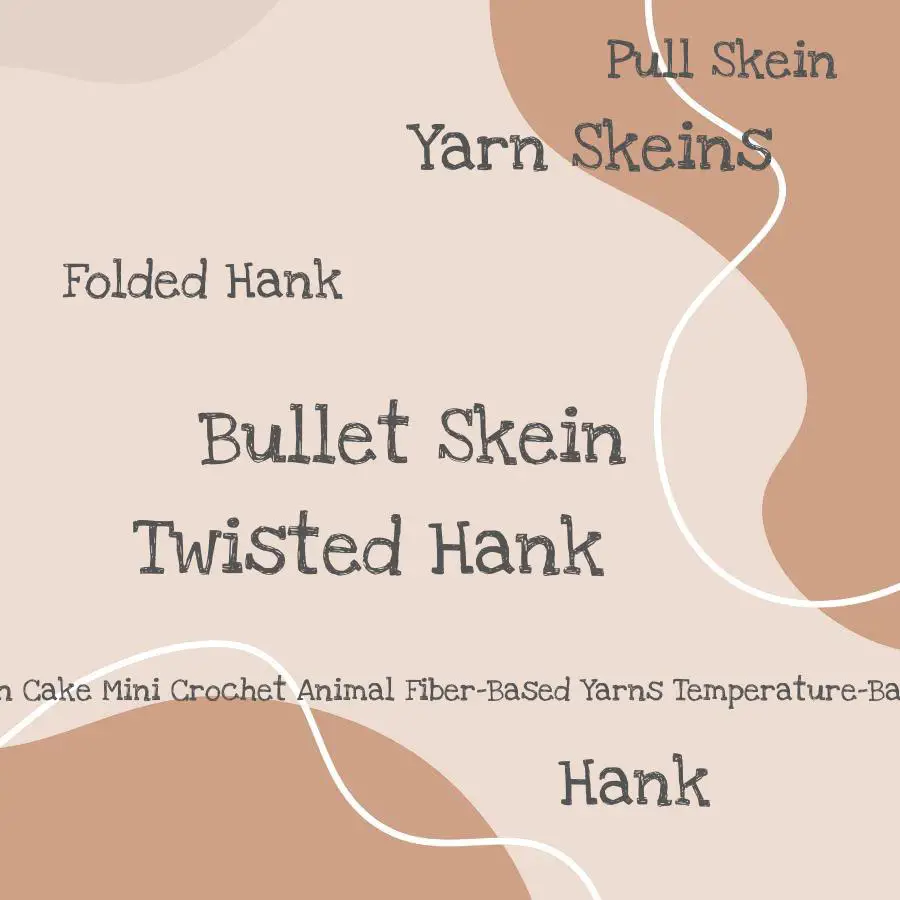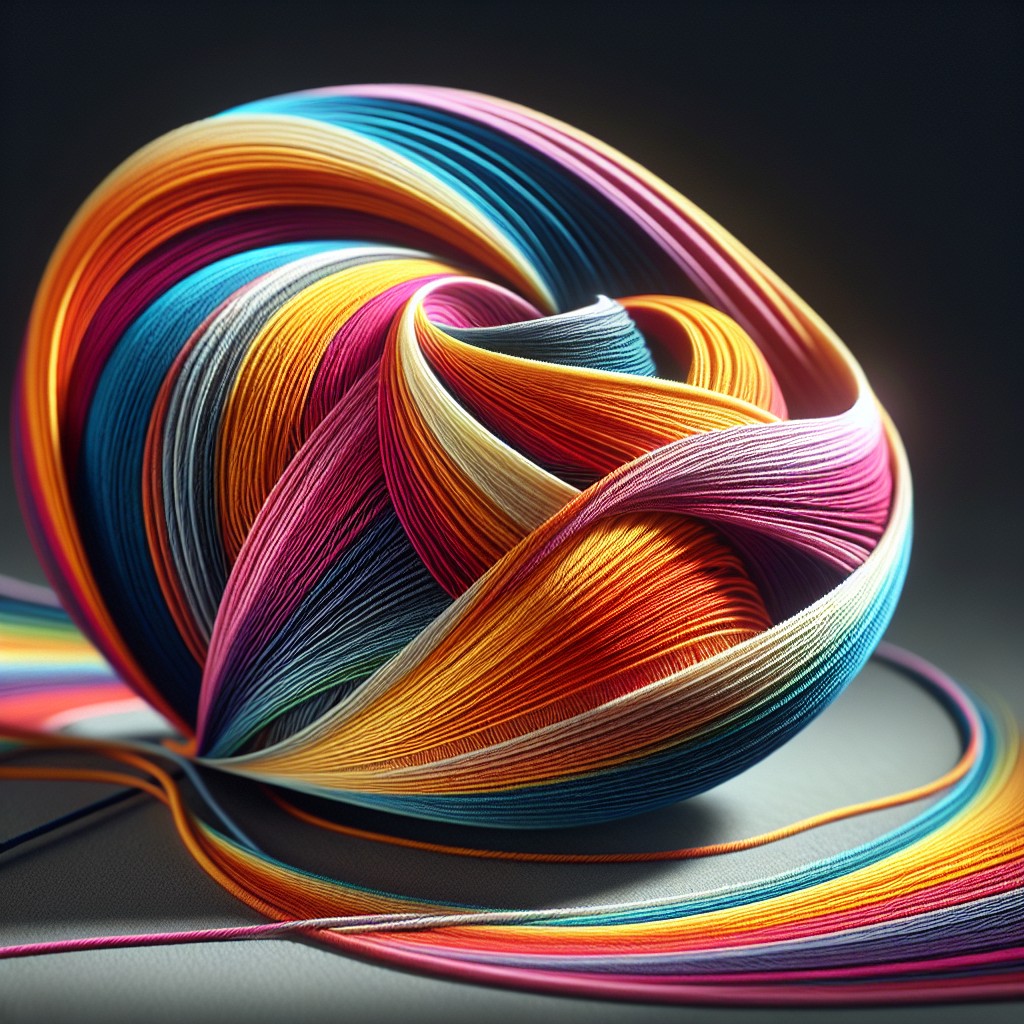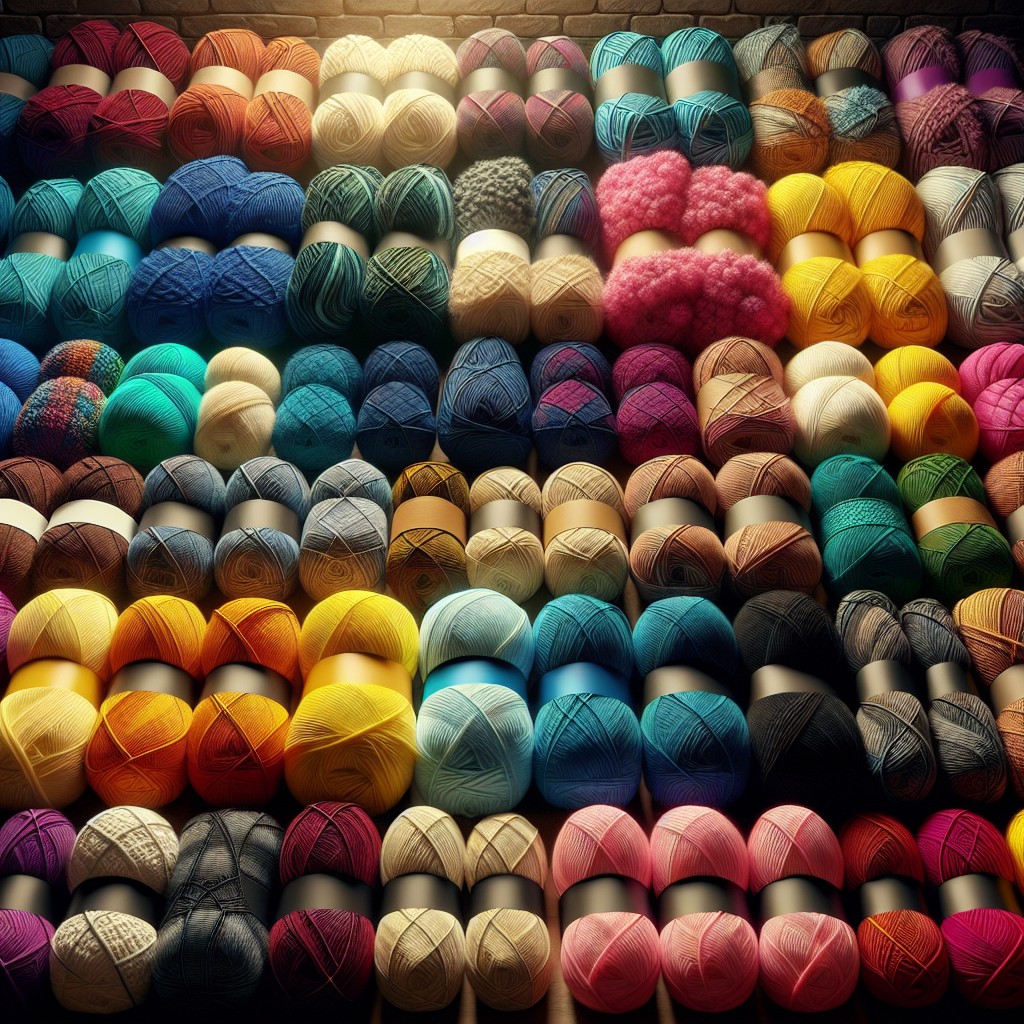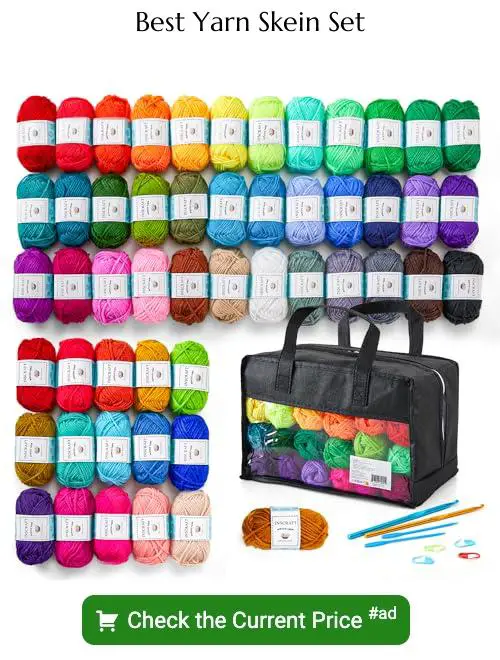Discover the diverse world of yarn skeins as we unravel the various types, textures, and uses that will elevate your knitting and crochet projects to new heights.
Are you a yarn enthusiast who loves to crochet or knit? If so, you know how important it is to choose the right type of yarn for your project. Yarn comes in various shapes and sizes, but one of the most common forms is the yarn skein.
In this blog post, we’ll explore different types of yarn skeins and their unique characteristics. Whether you’re a beginner or an experienced crafter, understanding these differences can help take your projects to the next level.
So grab your hooks and needles, and let’s dive into the world of yarn skeins!
Hank

It’s typically used for hand-dyed or specialty yarns and can be made from various fibers such as wool, silk, cotton or alpaca. Hanks are often sold by weight rather than yardage because the length of each hank can vary depending on the thickness and density of the fiber.
One thing to keep in mind when working with hanks is that they need to be wound into balls before use. This process helps prevent tangles and ensures even tension throughout your project.
You can either wind them by hand using a swift (a tool designed specifically for this purpose) or use a ball winder which makes winding much faster.
Hanks are an excellent choice if you’re looking for unique colors and textures since they’re often dyed individually by small-scale producers who take pride in their craftmanship. They also tend to have more yardage per skein compared to other types of yarn skeins making them ideal for larger projects like blankets or shawls.
Folded Hank

This creates a compact, easy-to-store package that can be easily unwound as you work on your project. Folded hanks are often used for hand-dyed or specialty yarns because they allow the colors to blend together in unique ways.
When working with a folded hank, it’s important to take care when unraveling it so as not to tangle the yarn. Start by finding one end of the fold and gently pulling it out until you reach the center twist.
Then, carefully untwist each side of the fold until you have two separate strands.
Twisted Hank
This method of twisting creates an even tension throughout the skein, making it easier to work with and preventing any unwanted knots or tangles. Twisted hanks are often used for hand-dyed yarns as they allow the dye to penetrate evenly throughout the fibers.
When working with a twisted hank, you’ll need to unwind it carefully so as not to create any snarls or knots. One way is by placing your hands on either side of one loop and gently pulling apart until you reach the end of that loop.
Repeat this process until all loops have been undone.
Twisted hanks can be found in various fiber types such as wool, cotton, silk, alpaca among others; each offering unique characteristics when worked up into projects like scarves or sweaters.
Skein

They come in various shapes and sizes, but they all have one thing in common: a loose, coiled shape that makes them easy to work with. Skeins can be made from different materials such as wool, cotton or acrylic fibers.
One type of skein is the pull skein which has an outer end that you can easily find and pull out without having to unwind it completely. This makes it convenient for crocheting or knitting on-the-go since you don’t need to worry about tangling your yarn while working.
Another type is the bullet skein which has a pointed end making it easier to start working with compared to other types where finding an end may require some effort.
Lastly, there’s also twisted hank which comes in long loops twisted together into a figure-eight shape then tied at intervals creating multiple smaller loops within each twist. Twisted hanks are great for dyeing because they allow more surface area exposure than regular hanks due their unique structure.
Pull Skein

This design allows you to easily pull out the yarn from the center without having to unwind it manually. Pull skeins are perfect for larger projects as they provide uninterrupted access to your yarn, making them ideal for blankets, shawls, and other similar items.
One of the benefits of using a pull skein is that it eliminates tangles and knots while working on your project. You can simply grab onto one end and start crocheting or knitting without worrying about any snags or twists in your thread.
Pull skeins come in various sizes depending on how much yardage you need for your project. They also come in different materials such as wool, cotton, acrylics among others giving crafters plenty of options when choosing their preferred fiber content.
Bullet Skein
This type of skein is often used for hand-dyeing and can be easily dyed without any tangles or knots. The pointed ends make it easy to unwind the yarn from both sides, making it ideal for knitting or crocheting projects that require two strands at once.
One advantage of using bullet skeins is their compact size, which makes them easy to store and transport. They are also great for small projects like hats or scarves since they don’t take up much space in your project bag.
When working with this type of yarn, you’ll want to start by finding one end and pulling gently until you reach the other end. Once you have both ends accessible, wind them into balls before starting your project.
Ball
It’s a tightly wound bundle that can be easily pulled from the center or outside, depending on how it was wound. Balls are often used for smaller projects and are easy to store in your crafting bag or basket.
One thing to keep in mind when working with a ball is that it can sometimes roll away as you’re crocheting or knitting, so make sure to place it on a flat surface while working. If you’re using multiple balls for one project, be sure they have the same dye lot number to ensure consistency in color throughout your work.
Cake
It’s called a cake because it looks like one, with its flat top and bottom and cylindrical shape. Cakes are made by winding the yarn into a large, flat circle before folding it in half to create the cylindrical shape.
One of the benefits of using cakes is that they allow you to see all the colors in your project at once since they’re wound from end-to-end instead of side-to-side like traditional balls or skeins. This makes them perfect for projects where color placement is important, such as gradient shawls or blankets.
Cakes also have an advantage over other types of skeins when it comes to storage. They take up less space than balls or hanks because their flattened shape allows them to be stacked easily on top of each other without rolling around.
Cakes are an excellent choice for any project where color placement matters and storage space is limited.
Donut Ball
It’s called a donut ball because it looks like, well, a donut! This type of skein is made by winding the yarn around itself in concentric circles to create a flat disc shape with an opening in the center. The opening makes it easy to pull out the end of the yarn without having to unravel everything.
One advantage of using Donut Balls for your projects is that they are less likely to roll away while you work on them compared to other types such as balls or cakes. They also take up less space than traditional balls or cones, making them ideal for small storage spaces.
Another benefit is that Donut Balls allow you more control over how much yarn you use at any given time since they come pre-wound into smaller portions than larger skeins. This feature can be especially helpful when working on intricate patterns where precision and consistency are key.
If you’re looking for an alternative way to store your favorite fibers while keeping things organized and tidy during crafting sessions – consider trying out some Donuts!.
Hard Core Ball
This type of skein is perfect for those who prefer their yarns to be more compact and less likely to unravel while working on their projects. Hard core balls are also great for storing your yarn as they take up less space than other types of skeins.
One advantage of using hard core balls is that they can be easily stacked or stored in containers without taking up too much space. They’re also ideal if you like working with smaller amounts of yarn at once, as you can unwind just the amount you need without having to worry about the rest unraveling.
When choosing a hard core ball, consider the fiber content and texture carefully since these factors will affect how your finished project looks and feels. Some fibers may not hold up well when wound tightly into this form, so it’s important to choose wisely based on what kind of project you have in mind.
Cone
It’s commonly used for industrial purposes, but it can also be used for home projects. Cones are perfect if you’re working on large-scale projects like blankets or sweaters because they contain more yarn than other types of skeins.
One advantage of using cones is that they have less packaging material compared to other types, which makes them eco-friendly and cost-effective. They’re also easy to store since their conical shape allows them to stack neatly on top of each other.
However, cones may not be suitable for all kinds of crochet or knitting projects as they require special equipment such as a cone holder or stand when in use. The weight and size may make it difficult to handle while working with smaller patterns.
Classic Pull Skein
It’s easy to use and store, making it an excellent choice for beginners or those who prefer convenience. The yarn is wound into the shape of a cylinder with one end pulled out slightly, allowing you to easily find the starting point when you’re ready to begin your project.
One advantage of using this type of skein is that it can be used straight away without any preparation required. You don’t need any special tools or equipment; simply pull from the center and start knitting or crocheting right away! This makes it ideal for on-the-go projects where you want something quick and easy.
Classic pull skeins come in various sizes, weights, colors, textures as well as fiber types such as wool blends or acrylics. They are also available at different price points depending on their quality level.
Yarn Cake
It’s called a cake because it looks like one, with its flat top and bottom and cylindrical shape. Yarn cakes are made by winding the yarn into a flat, oval shape before rolling it into the cylinder.
One of the benefits of using yarn cakes is that they allow you to see all the colors in your project at once since they’re wound in concentric circles around each other. This makes them perfect for projects where color placement matters, such as striped blankets or shawls.
Another advantage of using yarn cakes is their center-pull design which allows you to pull from either end without tangling or knotting up your work. This feature also makes them easy to store since they take up less space than traditional balls or skeins.
Mini Crochet
It involves using small amounts of yarn to create tiny, intricate designs that can be used as keychains, ornaments, or even jewelry. Mini crochet projects are perfect for those who want to try something new and challenging without committing too much time or resources.
To get started with mini crochet, you’ll need a few basic supplies such as a small hook (size 1-2mm), fine weight yarn (such as lace weight), and some patience! The smaller hook size allows you to work with finer details while the lightweight yarn ensures your project remains delicate.
One great thing about mini crochet is that it’s easy to take on-the-go. You can carry your supplies in a small bag and work on your project during commutes or breaks at work/school.
Mini-crochet offers an exciting way for crafters of all levels to experiment with different techniques while creating unique pieces that showcase their skills.
Everything You Need to Know About Skeins
They can be used for knitting, crocheting, weaving, and other fiber arts. Skeins are typically made by winding yarn around a cylindrical object such as a cone or tube until it forms an oblong shape.
One of the most common types of skein is the pull skein. This type of skein is wound into an oblong shape with one end left loose so that you can easily pull out the yarn from the center without having to unwind it first.
Another type of skein is called a bullet skein which has both ends tied together forming two loops at each end making them easy to store and transport.
A ball-shaped skein is another popular option for crafters who prefer their yarns pre-wound into balls before use. Balls come in different sizes depending on how much yardage they contain but generally weigh between 50-100 grams per ball.
Yarn cakes have become increasingly popular over recent years due to their unique appearance; they resemble small layered cakes with flat tops and bottoms while being wider than traditional balls or hanks allowing you more surface area when working on your project. Cone-shaped Skeins are commonly used by weavers because they hold large amounts (upwards 1kg)of continuous thread perfect for creating long pieces like scarves or blankets without needing frequent joins during work sessions.
Animal Fiber-Based Yarns
These types of skeins come from animals such as sheep, alpaca, llama or goat. They are known for their natural insulation properties which make them perfect for winter wearables like hats and scarves.
Wool is one of the most popular animal fiber-based yarns due to its versatility in texture and color options. It can be spun into different weights ranging from lace weight to bulky weight making it suitable for various projects.
Alpaca wool has a luxurious feel with excellent drape qualities that make it ideal for shawls or blankets while mohair provides an airy halo effect when used alone or blended with other fibers.
When working with these types of skeins keep in mind they require special care during washing because they tend to shrink if not handled properly.
Temperature-Based Skeins
These skeins are perfect for creating fun and interactive projects, such as scarves or blankets, that change colors with your body heat. Temperature-based yarns come in different types of fibers like wool, silk blends or cotton blends.
One popular example is the “thermo-chromic” yarn which changes color when exposed to heat above 27°C (80°F) and returns to its original shade once it cools down again. This type of yarn can be used in various ways; you could create a scarf that turns from blue to pink when you wear it outside on a sunny day!
Another option is “UV-reactive” skeins which change their hue under sunlight exposure due to photochromism – this means they react chemically with UV light causing them to shift shades temporarily.
Fabric Crochet
This method allows you to create beautiful and functional items such as rugs, bags, and even clothing. The process involves cutting long strips of fabric from old clothes or sheets and crocheting them together to form a sturdy piece.
One advantage of using this technique is that it’s an eco-friendly way to repurpose old fabrics into something new. It also adds texture and color variation to your projects since you can mix different types of fabrics.
To get started with Fabric Crochet, choose your desired fabric material (cotton works well), cut it into 1-2 inch wide strips, then join them together by sewing or knotting the ends. From there on out use any basic crochet stitch pattern like single crochet or double crochet stitches while working through each strip until reaching the end.
FAQ
Are all skeins of yarn the same?
Answer: No, all skeins of yarn are not the same, as they are sold by weight and may have different yardages.
What is the difference between a hank and a skein?
Difference: A hank is a larger unit of measurement for yarn, while a skein is typically 1/6th the size of a hank, with specific lengths for different materials (e.g., 8.25 yards for stranded cotton, 10 yards for tapestry wool, and 33 yards for crewel wool).
What are the different types of yarn put ups?
Answer: The different types of yarn put ups include skein, ball, hank, and cake.
What are balls of yarn called?
A skein of yarn is a cylindrical shape that yarn typically takes, often associated with balls of yarn.
How does the presentation of yarn in skeins affect the knitting or crocheting experience?
The presentation of yarn in skeins affects the knitting or crocheting experience by making it easier to manage, control tension, and prevent tangling during the creative process.
Can yarn types be determined by the way they are wound into skeins, balls, or hanks?
Yarn types can be partially determined by the way they are wound into skeins, balls, or hanks, but other factors such as fiber content and texture should be considered as well.
How do I properly store and organize various types of yarn skeins to prevent tangling and damage?
To properly store and organize various types of yarn skeins, preventing tangling and damage, utilize storage containers, keep them separated, and maintain similar yarn types together.





